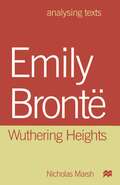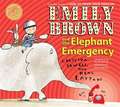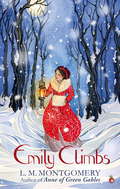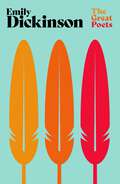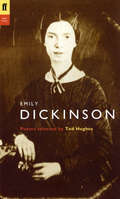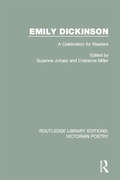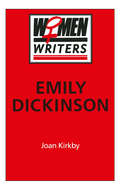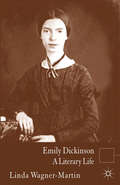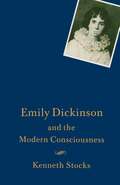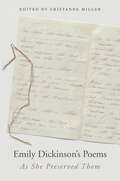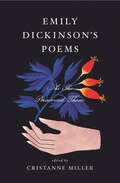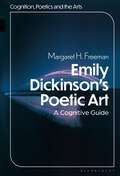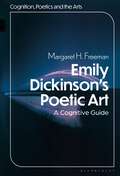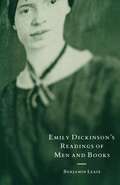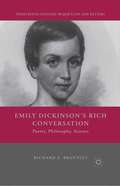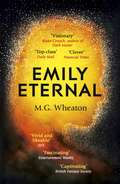- Table View
- List View
Emily Bronte and the Religious Imagination
by Simon MarsdenReaders of Emily Brontë's poetry and of Wuthering Heights have seen in their author, variously, a devout if somewhat unorthodox Christian, a heretic, or a visionary "mystic of the moors". Rather than seeking to resolve this matter, Emily Brontë and the Religious Imagination suggests that such conflicting readings are the product of tensions, conflicts and ambiguities within the texts themselves. Rejecting the idea that a single, coherent set of religious doctrines are to be found in Brontë's work, this book argues that Wuthering Heights and the poems dramatise individual experiences of faith in the context of a world in which such faith is always conflicted, always threatened. Brontë's work dramatises the experience of imaginative faith that is always contested by the presence of other voices, other worldviews. Her characters cling to visionary faith in the face of death and mortality, awaiting and anticipating a final vindication, an eschatological fulfilment that always lies in a future beyond the scope of the text.
Emily Brontë Reappraised
by Claire O'CallaghanEmily Brontë occupies a special place in the English literary canon. And rightly so: the incomparable Wuthering Heights is a novel that has bewitched us for almost 200 years, and the character of Heathcliff is, perhaps, the ultimate romantic hero – and villain. But Emily herself remains an enigmatic figure, often portrayed as awkward, as a misanthrope, as "no normal being". That's the conventional wisdom on Emily as a person, but is it accurate, is it fair? In this biography with a twist, Claire O'Callaghan conjures a new image of Emily and rehabilitates her reputation by exploring the themes of her life and work – her feminism, her passion for the natural world – as well as the art she has inspired, and even the "fake news" stories about her. What we discover is that she was, in fact, a thoroughly modern woman. And now, in the 21st century, it's time for the real Emily Brontë to please stand up.“Thoughtful…an informally written, no-nonsense reappraisal…much more readable than most jargon-riggen academic articles.” Jacqueline Banerjee, Times Literary Supplement"A fascinating read.” Hephzibah Anderson, Mail on Sunday“O’Callaghan clearly knows her stuff… An original, valuable contribution that goes a long way to rehabilitating the image of one of the most influential female figures in English literature.” Katherine Clements, Northern Soul
Emily Bronte: Wuthering Heights (Analysing Texts)
by Nicholas MarshChapters on the narrative frame, characters, imagery and symbols, structure and themes use practical analysis to build and refine our insight into Wuthering Heights. Part Two gives information about Emily Brontë's life and works, a discussion of this novel's place in the development of fiction and a comparison of three important critical views. Suggestions for further reading, fully explained examples of analysis and suggestions for further work make this volume both accessible and a bridge to further study.
Emily Bronte: Wuthering Heights (Analysing Texts)
by Nicholas MarshChapters on the narrative frame, characters, imagery and symbols, structure and themes use practical analysis to build and refine our insight into Wuthering Heights. Part Two gives information about Emily Brontë's life and works, a discussion of this novel's place in the development of fiction and a comparison of three important critical views. Suggestions for further reading, fully explained examples of analysis and suggestions for further work make this volume both accessible and a bridge to further study.
Emily Brown and the Elephant Emergency (PDF)
by Neal Layton Cressida CowellEmily Brown, Stanley the bunny and Matilda the elephant are busy going on adventures, but every time they get to a particularly exciting part . . . Ring! Ring! goes the Emergency Telephone and it's Matilda's mummy on the end worrying that Matilda isn't wearing her wellies, or eating properly or almost anything. How can Emily Brown persuade her that sometimes adventures are good? This brilliant new title from this award-winning team is a witty and poignant book about the importance of spending quality time with your children and allowing them to explore the world around them.
Emily Brown and the Thing (PDF)
by Cressida Cowell Neal LaytonIn this warm-hearted and witty take on a classic theme - being scared of the dark - Emily and Stanley find a 'Thing' crying outside their window. They embark on a series of adventures to find everything he needs for a good night's sleep . . . but nothing seems to work. What is troubling the Thing, and why can't he get to sleep? Parents and children the world over will recognise all the bizarre excuses a child can make to keep the light on and a parent in the room at bedtime, and this story shows how important it is to talk to children, and find out what is really going on in the complex depths of a child's imagination.
Emily Climbs: A Virago Modern Classic (Virago Modern Classics #2)
by L. M. MontgomeryEmily never imagined Aunt Elizabeth would allow her to go to high school in Shrewsbury, and she's thrilled, especially as her close friends Ilse, Teddy and Perry will be there. But there are certain conditions: for the whole three years Emily must board with hateful Aunt Ruth, and she must promise to stop writing stories. To Emily, this is unthinkable, but she wants an education, and reluctantly agrees. With the move from her beloved home at New Moon to Aunt Ruth's house, Emily's world is turned upside down. Not only must she prove herself at school, despite rejection and jealousy, but she can no longer count on her friends. Her happy childhood friendships - especially with Teddy and Perry - start to turn into something more complicated and in a small-town, the merest hint of gossip can cause scandal.
Emily Dickinson: Everyman's Poetry (Everyman's Poetry #Vol. 38)
by Emily DickinsonThe best of Emily Dickinson's poemsEmily Dickinson (1830-86) was born in Amherst, Massachusetts, the daughter of a lawyer and politician. Despite receiving a good education she returned home to Amherst, where she spent the rest of her life, writing more than a poem a day until her death. Her refusal to compromise her highly condensed expression, which meant that only a tiny fraction of her work was published in her lifetime, makes her seem startlingly modern today
Emily Dickinson
by Emily Dickinson Ted HughesIn this series, a contemporary poet selects and introduces a poet of the past. By their choice of poems and by the personal and critical reactions they express in their prefaces, the editors offer insights into their own work as well as providing an accessible and passionate introduction to some of the greatest poets in our literature.Emily Dickinson (1830-86) was born in Amherst, Massachussetts, where she lived most of her life as a recluse, seldom leaving the house or receiving visitors. She published just a handful of poems in her lifetime, her first collection appearing posthumously in 1890.
Emily Dickinson: A Celebration for Readers (Routledge Library Editions: Victorian Poetry)
by Suzanne Juhasz Cristanne MillerThe focus of this title, first published in 1989, begins with Dickinson’s poems themselves and the ways in which we read them. There are three readings for each of the six poems under consideration that are both complementary and provocative. The selected poems show Dickinson speaking of herself in increasingly wider relationships – to love, the outside world, death and eternity – and are grouped together to reveal her overlapping attitudes and feelings. Other topics discussed range from general epistemological and critical considerations to the poet’s self-identification and the process of reading her poetry as a feminist critic. This title will be of interest to students of literature.
Emily Dickinson: A Celebration for Readers (Routledge Library Editions: Victorian Poetry)
by Suzanne Juhasz Cristanne MillerThe focus of this title, first published in 1989, begins with Dickinson’s poems themselves and the ways in which we read them. There are three readings for each of the six poems under consideration that are both complementary and provocative. The selected poems show Dickinson speaking of herself in increasingly wider relationships – to love, the outside world, death and eternity – and are grouped together to reveal her overlapping attitudes and feelings. Other topics discussed range from general epistemological and critical considerations to the poet’s self-identification and the process of reading her poetry as a feminist critic. This title will be of interest to students of literature.
Emily Dickinson: A Literary Life (Literary Lives)
by L. Wagner-MartinWith special attention to Emily Dickinson's growth into a poet, this literary biographical study charts Dickinson's hard-won brilliance as she worked, largely alone, to become the unique American woman writer of the nineteenth century.
Emily Dickinson and Hymn Culture: Tradition and Experience
by Victoria N. MorganExtending the critical discussion which has focused on the hymns of Isaac Watts as an influence on Emily Dickinson's poetry, this study brings to bear the hymnody of Dickinson's female forbears and contemporaries and considers Isaac Watts's position as a Dissenter for a fuller understanding of Dickinson's engagement with hymn culture. Victoria N. Morgan argues that the emphasis on autonomy in Watts, a quality connected to his position as a Dissenter, and the work of women hymnists, who sought to redefine God in ways more compatible with their own experience, posing a challenge to the hierarchical 'I-Thou' form of address found in traditional hymns, inspired Dickinson's adoption of hymnic forms. As she traces the powerful intersection of tradition and experience in Dickinson's poetry, Morgan shows Dickinson using the modes and motifs of hymn culture to manipulate the space between concept and experience-a space in which Dickinson challenges old ways of thinking and expresses her own innovative ideas on spirituality. Focusing on Dickinson's use of bee imagery and on her notions of religious design, Morgan situates the radical re-visioning of the divine found in Dickinson's 'alternative hymns' in the context of the poet's engagement with a community of hymn writers. In her use of the fluid imagery of flight and community as metaphors for the divine, Dickinson anticipates the ideas of feminist theologians who privilege community over hierarchy.
Emily Dickinson and Hymn Culture: Tradition and Experience
by Victoria N. MorganExtending the critical discussion which has focused on the hymns of Isaac Watts as an influence on Emily Dickinson's poetry, this study brings to bear the hymnody of Dickinson's female forbears and contemporaries and considers Isaac Watts's position as a Dissenter for a fuller understanding of Dickinson's engagement with hymn culture. Victoria N. Morgan argues that the emphasis on autonomy in Watts, a quality connected to his position as a Dissenter, and the work of women hymnists, who sought to redefine God in ways more compatible with their own experience, posing a challenge to the hierarchical 'I-Thou' form of address found in traditional hymns, inspired Dickinson's adoption of hymnic forms. As she traces the powerful intersection of tradition and experience in Dickinson's poetry, Morgan shows Dickinson using the modes and motifs of hymn culture to manipulate the space between concept and experience-a space in which Dickinson challenges old ways of thinking and expresses her own innovative ideas on spirituality. Focusing on Dickinson's use of bee imagery and on her notions of religious design, Morgan situates the radical re-visioning of the divine found in Dickinson's 'alternative hymns' in the context of the poet's engagement with a community of hymn writers. In her use of the fluid imagery of flight and community as metaphors for the divine, Dickinson anticipates the ideas of feminist theologians who privilege community over hierarchy.
Emily Dickinson’s Poems: As She Preserved Them
by Emily DickinsonCristanne Miller’s major edition of Dickinson’s poems presents the 1,100 poems the poet retained during her lifetime, in the form she retained them. Dickinson took pains to copy these poems onto folded sheets in fair hand, arguably to preserve them for posterity. Included are Dickinson’s alternate phrases and the editor’s notes and Introduction.
Emily Dickinson’s Poems: As She Preserved Them
by Emily DickinsonWidely considered the definitive edition of Emily Dickinson’s poems, this landmark collection presents her poems here for the first time “as she preserved them,” and in the order in which she wished them to appear. It is the only edition of Dickinson’s complete poems to distinguish clearly those she took pains to copy carefully onto folded sheets in fair hand—presumably to preserve them for posterity—from the ones she kept in rougher form. It is also unique among complete editions in presenting the alternate words and phrases Dickinson chose to use on the copies of the poems she kept, so that we can peer over her shoulder and see her composing and reworking her own poems.The world’s foremost scholar of Emily Dickinson, Cristanne Miller, guides us through these stunning poems with her deft and unobtrusive notes, helping us understand the poet’s quotations and allusions, and explaining how she composed, copied, and circulated her poems. Miller’s brilliant reordering of the poems transforms our experience of them.A true delight, this award-winning collection brings us closer than we have ever been to the writing practice of one of America’s greatest poets. With its clear, uncluttered page and beautiful production values, it is a gift for students of Emily Dickinson and for anyone who loves her poems.
Emily Dickinson's Poetic Art: A Cognitive Reading (Cognition, Poetics, and the Arts)
by Margaret H. FreemanEmily Dickinson's Poetic Art is both an exciting work of literary criticism on a central figure in American literature as well as an invitation for students and researchers to engage with cognitive literary studies. Emily Dickinson's poetry can be challenging and difficult. It paradoxically gives readers a feeling of closeness and intimacy while being puzzling and obscure. Critical interpretations of Dickinson's poems tend to focus on what they mean rather than on what kind of experience they create. A cognitive approach to literary criticism, based on recent cognitive research, helps readers experience and understand the hows and whys of what a poem is saying and doing. These include cognitive linguistic analysis, versification, prosody, cognitive metaphor, schema, blending, and iconicity, all of which explain the sensory, motor, and emotive processes that motivate Dickinson's conceptualizations.By experiencing Dickinson's poetry from a cognitive perspective, readers are able to better understand why we feel so close to the poet and why her poetry endures. Emily Dickinson's Poetic Art: A Cognitive Reading is an important contribution to the study of a major American poet as well as to the vibrant field of cognitive literary studies.
Emily Dickinson's Poetic Art: A Cognitive Reading (Cognition, Poetics, and the Arts)
by Margaret H. FreemanEmily Dickinson's Poetic Art is both an exciting work of literary criticism on a central figure in American literature as well as an invitation for students and researchers to engage with cognitive literary studies. Emily Dickinson's poetry can be challenging and difficult. It paradoxically gives readers a feeling of closeness and intimacy while being puzzling and obscure. Critical interpretations of Dickinson's poems tend to focus on what they mean rather than on what kind of experience they create. A cognitive approach to literary criticism, based on recent cognitive research, helps readers experience and understand the hows and whys of what a poem is saying and doing. These include cognitive linguistic analysis, versification, prosody, cognitive metaphor, schema, blending, and iconicity, all of which explain the sensory, motor, and emotive processes that motivate Dickinson's conceptualizations.By experiencing Dickinson's poetry from a cognitive perspective, readers are able to better understand why we feel so close to the poet and why her poetry endures. Emily Dickinson's Poetic Art: A Cognitive Reading is an important contribution to the study of a major American poet as well as to the vibrant field of cognitive literary studies.
Emily Dickinson's Rich Conversation: Poetry, Philosophy, Science (Nineteenth-Century Major Lives and Letters)
by R. BrantleyEmily Dickinson's Rich Conversation is a comprehensive account of Emily Dickinson's aesthetic and intellectual life. Contrary to the image of the isolated poet, this ambitious study reveals Dickinson's agile mind developing through conversation with a community of contemporaries.
Emily Eternal
by M. G. WheatonMeet Emily - she can solve advanced mathematical problems, unlock the mind's deepest secrets and even fix your truck's air con, but unfortunately, she can't restart the Sun.Emily Eternal feels like hope in the face of the end of the world'CultureFlyEmily is an artificial consciousness, designed in a lab to help humans process trauma, which is particularly helpful when the sun begins to die 5 billion years before scientists agreed it was supposed to.So, her beloved human race is screwed, and so is Emily. That is, until she finds a potential answer buried deep in the human genome. But before her solution can be tested, her lab is brutally attacked, and Emily is forced to go on the run with two human companions - college student Jason and small-town Sheriff, Mayra.As the sun's death draws near, Emily and her friends must race against time to save humanity. But before long it becomes clear that it's not only the species at stake, but also that which makes us most human.PRAISE FOR EMILY ETERNAL'A visionary work of science fiction' Blake Crouch, author of DARK MATTER'A top-class, high-tech thriller. Emily is a true heroine: warm, funny, brilliant and more human than a lot of humans. You'll be cheering for her to the end' Daily Mail'Remarkably clever and engrossing . . . It's hard not to be won over by Emily's benign narrative voice and thrilled by the race-against-time plot, even as the book explores weighty questions of self and soul' Financial Times'Sparsely drawn, but vivid and likeable . . . M.G. Wheaton writes his lead character with charming warmth' SFX'Captivating . . . a unique portrayal of the end of the world and a taste of what comes after it. If this is all we see of Emily it will be a bittersweet disappointment' British Fantasy Society
Emily Goes to Exeter: A Novel Of Regency England - Being The First Volume Of The Traveling Matchmaker (The Travelling Matchmaker Series #1)
by M.C. BeatonThe first book in M.C. Beaton's charming Travelling Matchmaker series. A dead employer's legacy of five thousand pounds allows spinster Hannah Pym to resign from housekeeping and find adventure travelling the English countryside by stagecoach. But adventure soon finds Miss Pym in the form of Miss Emily Freemantle, a spoilt violet-eyed beauty fleeing an arranged marriage to a rake she has never met.When the girl's darkly handsome betrothed boards their stage, Miss Pym is certain Emily was rash to bolt from this aristocratic catch! And so as soon as the travellers repair to an inn, Miss Pym begins her matchmaking... and although Lord Ranger Harley complains he'll not marry an ungrateful minx, Miss Pym suspects once she's marshalled the couple into sharing intimate household chores, all romantic knots will be untangled!'Romance fans are in for a treat' - Booklist'[M. C. Beaton] is the best of the Regency writers' - Kirkus Reviews
Emily Lime: Librarian Detective - The Book Case (An\emily Lime Mystery Ser. #1)
by Dave SheltonEMILY LIME is the one and only LIBRARIAN DETECTIVE! As Assistant Librarian (and a pupil!) at St Rita’s School, she’s got the sharpest mind going. And she’s going to need it!There’s been a bank robbery in town, a break-in at the school and a dastardly villain is on the loose. With the help of new girl, Daphne, and George (the only boy), Emily is determined to get to the bottom of things, with surprising and very funny results . . . 'Blends Enid Blyton's Malory Towers stories with a touch of Sherlock Holmes. Deliciously funny and a must for mystery fans' The Week Junior



